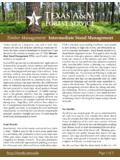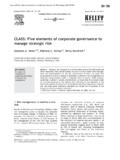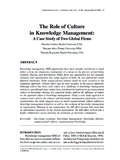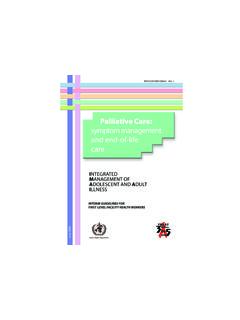Transcription of Guidelines for Clinical Risk Assessment and Management in …
1 Guidelines forCLINICAL RISK Assessment andMANAGEMENTin MENTAL HEALTH SERVICESM inistry of Healthin partnership with theHealth Funding AuthorityJuly 1998 DisclaimerWhile every care has been taken in the preparation of the information contained in this document,users are reminded that the Ministry of Health cannot accept any legal liability for any errors oromissions or damages resulting from reliance on the information contained in this for Clinical Risk Assessment and ManagementiiAny feedback on this document should be sent toDr Nick Judson, Deputy Director of Mental Health,Ministry of Health, PO Box 5013, Wellington, New the source is acknowledged, the information contained in this document may be freely July 1998 Ministry of with the permission of the Director-General of : 0-478-22850-3 (booklet)ISBN: 0-478-22853-8 (internet) Guidelines for Clinical Risk Assessment and ManagementiiiForewordA frequent finding in inquiries into failures of mental health services, both here andoverseas, is a lack of robust risk Assessment and Management .
2 The language of risk has become the predominant discourse, not just in Clinical practice but across anincreasingly wide range of government and private activities, and dealing with both the hazards and the outrage is an increasing practice always carries some risk. Good Clinical Management requires skill,experience, and careful judgement, applied to a sound base of information andknowledge. It is vital that clinicians working in mental health services are wellinformed and appropriately skilled in the Assessment and Management of the range ofrisks that they are presented with. Many services and clinicians have already beenactive in the development of good protocols and practices. These Guidelines have beenwritten to assist in this process of project has been a co-operative venture. I would to thank the following: the Health Funding Authority for funding the project Waitemata Health, Nelson-Marlborough Health, Capital Coast Health andHealthlink South, who provided staff to participate in the working group the Mental Health Commission for the close collaboration between this project andtheir review of Clinical risk Management in hospital and health services (previouslyknown as CHEs) the members of the working group for the skills and enthusiasm that they brought tothe task Dr Nick Judson for his leadership and commitment to this Janice WilsonDirector of Mental HealthGuidelines for Clinical Risk Assessment and concept of kinds of risk?
3 3 Characteristics of of of risk of of of of process of risk Management and transfer of Assessment and Management of 1: Risk of harm to and mental the risk of 2: 3: Risk through 4: Privacy to protect a third 5: Cultural 6: Working for Clinical Risk Assessment and Management1 PurposeThese Guidelines are written to provide a basic framework to guide and aid mentalhealth clinicians to better assess and manage Clinical risk. They cover all mental healthsettings and disciplines, not just acute inpatient or forensic settings, and are equallyrelevant to crisis teams and community-based risk Assessment and Management occurs in the context of broader riskmanagement organisational, financial, political, legal and so on. These guidelinesfocus on Clinical is the responsibility of every mental health service to ensure that the appropriatestrategies, protocols, teaching programmes and audit procedures are developed document aims to be brief, readable and practical.
4 It does not attempt to cover alleventualities, nor is it over prescriptive, but it sets out general principles common to allrisk Assessment and Management . More specific information is contained in for Clinical Risk Assessment and Management2 IntroductionThere is a particular onus on the mental health clinician to assess and manage clinicalrisks in a way that stands up to scrutiny, and for mental health services to developdecision-making processes and competencies with regard to levels of risk predictions of dangerousness 1 are rarely useful. What is useful is a pictureof what circumstances are likely to lead to an increased risk. This requires a detailedpicture of the individual, the characteristics and course of the illness, details ofcircumstances and situations where particular behaviours or problems arise/have arisen,effective/ineffective interventions, and previous outcomes.
5 A plan of Management ,based on this information, should aim to minimise risk and strike a balance of risks tothe individual and to is only of use if it leads to better Management , and hence better Assessment is not complete until a formulation of risk is made and a plan ofmanagement drawn concept of riskDefinitionsRisk is the likelihood of an adverse event or factorsare the particular features of illness, behaviour or circumstances thatalone or in combination lead to an increased Assessment is an estimation of the likelihood of particular adverse eventsoccurring under particular circumstances within a specified period of formulationis a process of summary and organisation of the risk data, andidentification of the risk factors. It provides the information base for risk Management aims to minimise the likelihood of adverse events within thecontext of the overall Management of an individual, to achieve the best possibleoutcome, and deliver safe, appropriate, effective care.
6 1 For example, rating an individual as high risk or dangerous without any contextual for Clinical Risk Assessment and Management3 What kinds of risk?Risk Assessment is broader than just the risk of violence to others, though this is ofmost concern to the public and principal categories of risk2 are broadly: the risk of progression of illness risk to health of the individual the risk of deliberately induced harm to self including suicide the risk of unintentional harm to self, or exploitation the risk of intentional or unintentional violence, or fear-inducing behaviour include: risks TO SELFRISKS TO OTHERS safety (including suicidal acts, deliberateself harm) health (including drug and alcohol abuse,physical harm, psychological harm) quality of life (including dignity, social andfinancial status) vulnerability (including exploitation,sexual abuse and violence from others) self-neglect cultural/spiritual violence (including emotional, sexual andphysical violence) intimidation/threats neglect/abuse of dependants stalking/harassment property damage (including arson) public nuisance reckless behaviour (including driving) risks may also be posed to consumers/patients by systems and treatment itself, such asside-effects of medication, ineffective care, institutionalisation and social risks are often neglected when considering a Management plan but should becarefully of risk Risk fluctuates and is not a static state (hence a need for regular reassessment).
7 Degree of risk does not necessarily equate to legal status. Assessment /prediction is more accurate in the short term (and is never 100%accurate). There are critical points in Management of risk (see below). The most important way to minimise risk is good Clinical Management . Reliance upon actuarial3 factors alone is unwise. 2 There are similarities between these categories and those in the definition of mental disorder in s2of the Mental Health (Compulsory Assessment and Treatment) Act Actuarial risks are the probabilities of risk based on the whole population for Clinical Risk Assessment and Management4 Assessment of riskRisk Assessment is an integral part of every Clinical observation or Assessment . Riskassessment does not occur on a one off basis, but is ongoing, with a particularemphasis at critical points , such as: first contact with a service change or transfer of care change in legal status change in life events (eg, loss) significant change in mental state discharge, or move to a less restrictive individuals presenting to, or under the care of a mental health service should beassessed for risk.
8 The detail and specificity of such Assessment will vary according tocircumstance and past behaviours, but every individual should at least be screened urgent situations it may not be possible to assess all historical factors: a minimumincludes the first two columns in the table below. Awareness of risk should beparticularly high in urgent/emergency should be reassessed at regular intervals and any change in risk (increase ordecrease) should be there is now much documentation and research, there is no foolproof systemfor prediction. Assessment must be based on a thorough collection of informationfrom all available sources and cover all aspects of the illness, background, behaviourand circumstances of the individual. A full Assessment should consider the factorslisted in Table 1 on page clinician expected to carry out a risk Assessment should be trained to do should be made by staff with appropriate skills, cultural expertise andgender.
9 Interpreters should be used if required. Services should ensure that staffknow when to seek a more specialised Assessment (eg, from forensic services orcultural specialist).The background of the assessor (attitudes, gender, culture, age) and the circumstancesof the Assessment will impact on the outcome of the for Clinical Risk Assessment and Management5 Table 1: Factors to consider when assessing riskMENTAL STATEENVIRONMENT/CURRENTFACTORSHISTORICA LINFORMATIONB ehaviour Dangerous or threatening actions Verbal/non-verbal risks Deliberate self harm AggressionAffect Arousal, anger, hostility,irritability, suspiciousness, fear Low mood or elevated moodCognition Thoughts or fantasies ofdeliberate self harm or harm toothers Persecutory thoughts, delusions External control Confusion Preoccupation, obsession,jealousy Control over-ride Cultural beliefsPerceptions Command hallucinations(especially linked with delusionalbeliefs)
10 Misidentification Matakite4 Immediate stressors Substance use, intoxicationor withdrawal Relationships Presence or absence ofsupport Presence/absence oftreatment, non-compliancewith treatment Persecution or threats fromothers Arrest or criminal charges Loss including death of apeer Cultural transgression Financial stressAccess To weapons, pills, victimsSituation Home, prison, hospital, etcIndividual s attitude Co-operation Refusal to co-operate(including fear ofcompulsory treatmentprocess)Illness and incidents Patterns of illness Psychiatric history History of incidents(and context) Treatment andoutcomes Features of past crises Personal historyPersonality Usual coping styleFamily background Demographics, age,sex Culture DynamicsLimits of risk assessmentIt is not possible to identify and eliminate risk entirely. Even in the best ofcircumstances, and using the most carefully applied Assessment and managementmethods, adverse events will still occur from time to time.










